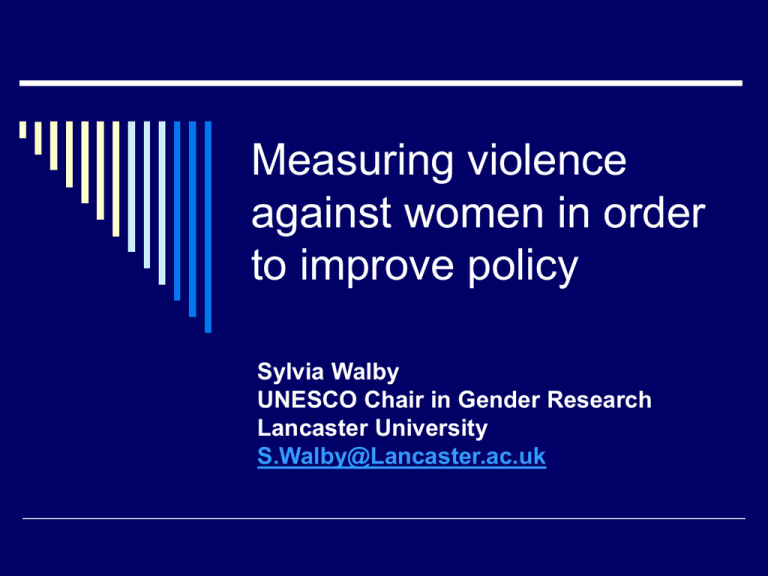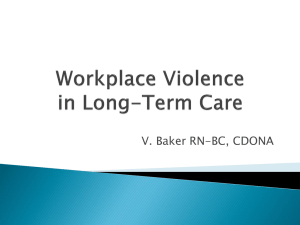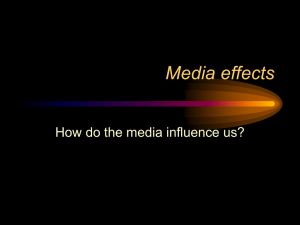walby - Women Against Violence Europe
advertisement

Measuring violence against women in order to improve policy Sylvia Walby UNESCO Chair in Gender Research Lancaster University S.Walby@Lancaster.ac.uk Introduction Measurement, indicators and policy development What are indicators? Indicators of extent and severity How to measure in surveys Indicators of impact Cost? Indicators of policy performance What information? What has been achieved? What next? Measurement, indicators and policy development Lots of well-intentioned new policy initiatives But do they work? Need robust information that is comparable over time in order to evaluate policy developments Indicators Why indicators? Key link between policy and statistics To simplify complex information To assess if there is progress Criteria for selection Unambiguous and easy to interpret Enable an assessment of progress or not Neither so many as to confuse, nor so few as to mislead Capable of support by reliable data that is comparable over time Do not create perverse incentives Indicators of extent and severity Inclusive scope of types of violence, but not so specialised as to prevent comparison between countries Meaningful measurement of the extent of the violence: both prevalence and number of incidents; Meaningful measurement of severity of violence Consistent time period: both a longer period e.g. life-time and a more recent period, e.g. last year Consistent population sub-set, e.g. age Consistent with indicators in adjacent fields, so as to facilitate the mainstreaming of violence against women into mainstream data collection and policy development, while still being sensitive to the nuances in the specific field of violence against women. Femicide? ‘Femicide’ has the advantage of power and simplicity Derived from administrative sources so useful addition to survey data But very few countries if any collect data that distinguishes between homicide that is genderbased from that which is not Technical issues of definition and practice to develop Premature, but worth developing. Incidents and/or prevalence in intimate partner violence Prevalence: rate (%) of violence against women in the female population Incidents: number of incidents of violence against women per unit (e.g. 100, or 1,000) of female population Intimate partner violence: incidents and gender (UK, BCS) Women Men % against Ratio: women Women: men Victims 657,000 356,000 65% Average number incidents per victim 20 7 Total incidents 12.9 million 2.5 million 1.8 2.9 84% 5.2 Gender implications of different measures Prevalence is the least gender asymmetrical indicator Number of incidents more gender asymmetrical than prevalence. domestic violence prevalence: 4% women, 2% men average no. incidents of dv.: women 20, men 7 incidents dv: 12.9 million against women, 2.4m men DV one incident: 28% women, 47% men Injuries more gender asymmetrical than no. of incidents, since women more likely to be injured than men in each. Minor force, 49% women 36% men sustain physical injury Severe force, 77% women 56% men sustain physical injury Indicator: Number of incidents of intimate partner violence Advantages Does not produce spurious gender symmetry when men are asked the same questions Easier to mainstream into adjacent policy fields which use number of incidents - essential for funding Disadvantages Not in common use in VAW community which prefers to focus on the underlying ‘course of conduct’ Recommend: Priority use of ‘incidents’; also use prevalence as a secondary indicator Measuring extent of gender-based violence Administrative statistics? Problems: Most incidents not reported to services Reporting categories obscure gender-based violence e.g. domestic violence rarely a ‘crime’ category, nor a ‘diagnostic code’ in health Large scale survey Expensive But is only reliable source of data on extent Measuring extent of gender-based violence e.g. British Crime Survey Domestic violence, sexual assault, stalking Self-completion module additional to main face-to-face interviews Confidentiality produces 5 times higher rate of disclosure Sample: 22,463 nationally representative Men as well as women Aged 16-59 Indicators of impact Impact in its own terms: violence, abuse, pain and suffering Impact as a violation of women’s human rights Impact as a crime Impact as a detriment to health Impact as a cost to society Why measure the cost? Domestic violence has devastating impact Justice and fairness a sufficient basis for policy Drains resources of society as well as abused A financial dimension increases the ways policies are articulated, measured and evaluated Facilitates comparison with other policies in spending decisions Mainstreams gender into mainline policy Evidence base for policy making Cost of domestic violence in Britain: Methodological framework Domestic violence (including domestic rape) in Britain Framework based on Home Office Research Study 217 by Brand and Price 2000 on the cost of crime Developed so as to include specific costs related to domestic violence e.g. housing and refuges, social services, civil legal services. Information needs Extent, nature and impact of domestic violence Costs of services, lost economic output, and public’s willingness-to-pay to avoid human costs of pain and suffering. Actual level of service use e.g. from reports from service providers. Types of Cost Use of services, often public services 1. • • • • • 2. 3. Criminal justice system Health care Social services Housing and refuges Civil legal services (including legal aid) Lost economic output, e.g. time off sick Human cost of pain and suffering, based on public’s willingness-to-pay Criminal Justice System Cost: £1 billion 24% of cost of CJS for violent incidents 8% of total cost of CJS Basis of estimate: Number of violent crimes recorded by police London Met cross-classification of offences by dv or not ‘Non-crime domestic incidents’ recorded by police Domestic homicide: data from Criminal Statistics Cost of each type of incident, HO estimates Flows and costs model for courts etc Police recorded time use in diaries Health Care Cost £1.4 billion £1.2 billion physical injuries, £176 million mental care e.g. depression Estimates based on: DfT estimates of medical care costs of injuries, used by HO Crime and injury association, HO practice Increased service use for mental health (e.g. depression) associated with domestic violence Social Services and Children Cost £.25 billion Primarily for children caught up in co- occurrence of domestic violence and child abuse Estimates based on PSSRU data on social service costs for children in need and being looked after 40% co-occurrence of domestic violence and child abuse finding from other studies Housing and refuges Cost £.16 billion Housing those made homeless due to domestic violence Local Housing Authority (+SL) costs, estimates from CIPFA Refuges Housing benefit: LHA and refuges Loss of owner occupied housing Moving home Civil Legal Costs £.3 billion Half state (especially legal aid), half individual Specialist legal actions e.g. injunctions to restrain or expel a violent partner Legal actions for divorce and separation plus associated child custody, finances. Estimates based on Judicial Statistics Lord Chancellors’ Dept Legal Services Commission (legal aid) Legal Aid Board Research Unit research Economic Output Cost £2.7 billion Half employer, half employee Cost of time off work due to injuries Based on DfT estimates for losses associated with injuries Injuries associated with crimes, following HO practice Number of people from British Crime Survey (Walby and Allen 2004) Human and emotional costs £17 billion Based on Public’s ‘willingness-to-pay’ to avoid the pain and human suffering of injuries DfT estimates for costs associated with injuries, as associated with crimes and used by HO Number of people from the British Crime Survey (Walby and Allen 2004) Total cost Total Cost: £23 billion a year State, £3.1 billion, for public services Lost economic output £1.3 billion by employers, £1.3 billion by individuals Human and emotional costs, £17 billion individuals Indicators of policy performance Performance of services in prevention, protection and provision of support State duty; is there a national plan? Measure availability and quality of services E.g. is the legal framework adequate? How many refuge places? Sexual assault services exist? Measure use of services? Do they know whether people are using because of gbv (e.g. health)? Monitor impact of services Develop indicators of best quantity and quality of each service and total service provision What has been achieved? What next? Measurement of extent Many EU countries have had one survey, but very few have a series that measures changes over time EU-wide survey of gender-based violence? Some discussion only Agreement on indicators of extent? Suggested, not implemented: insufficient survey data Measurement of impact: cost? Only a few countries; no EU-wide. Measurement of policy performance Some targets for some basic services in some countries Some national plans Only just started Two Reports Sylvia Walby and Jonathan Allen (2004) Domestic Violence, Sexual Assault and Stalking: Findings from the British Crime Survey. Home Office Research Study 276. www.homeoffice.gov.uk/rds/pdfs04/hors276.pdf Sylvia Walby (2004) The Cost of Domestic Violence DTI Women and Equality Unit. http://www.womenandequalityunit.gov.uk/research/c ost_of_dv_Report_sept04.pdf.









